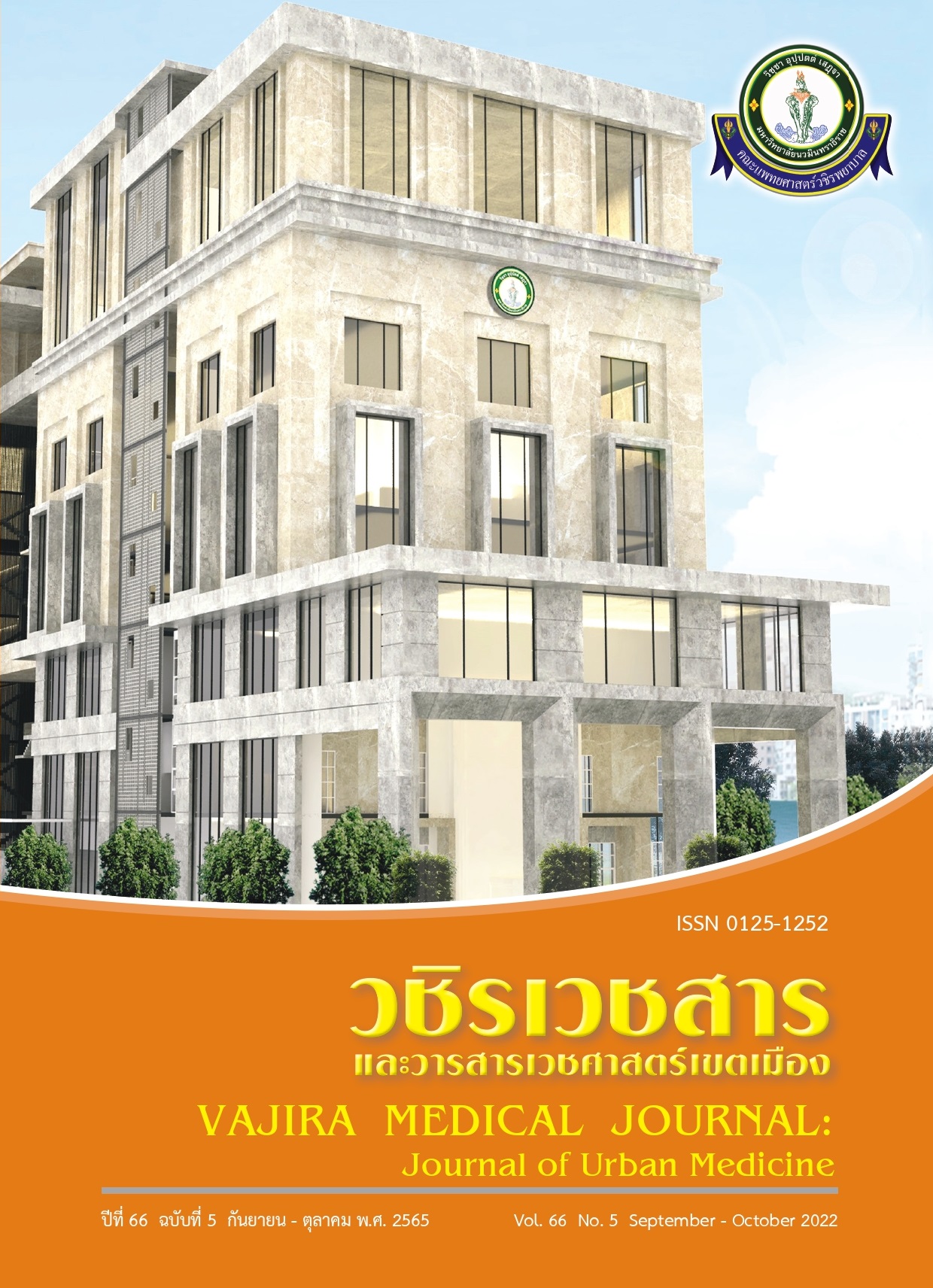[Retracted] Incidence of Prostate Cancer in Physical Checkup Population with Rising of Serum Prostatic Specific Antigen
Main Article Content
Abstract
Objective: To assess the prevalence of prostate cancer in northern Thailand.
Methods: This study was performed with a cohort study at the health check-ups clinic at University of Phayao Hospital from July 2021 until October 2021. In total, prostate gland check-ups and Prostate-specific antigen (PSA) screening was made available to 350 patients aged at least 45 years, and a number of parameters were recorded: International prostate symptom score (IPSS), Body mass index (BMI), Digital Rectal Examination (DRE) and Quality of Life score (QOL) score. Those patients whose PSA level was more than 4 ng/ml were advised to have a transrectal ultrasound (TRUS) biopsy of prostate. The cancer detection rate was determined on the basis of reported symptoms and the IPSS. Comparisons among data were assessed via the Chi-square test, while Spearman correlation was used to compare the PSA level and the Gleason score.
Results: For the study subjects, the median age was 63 years (45-81); median BMI was 23.4 (18.2-32.4) kg/m2, median IPSS score was 11(0-32); median QOL score was 2(0-6); and median PSA was 1.23 (0.12-125.7) ng/ml. Upon biopsy, 7.54% of the sample participants (26/350) could be determined to have prostate adenocarcinoma. A majority of those cases exhibited localized lesions. Participants who considered themselves to have abnormal urination were more likely to also have prostate cancer. Only one prostate cancer case was discovered in a participant with mild LUTS, as indicated by IPSS below 8. Typically, prostate cancer occurred more frequently in males with high IPSS scores.
Conclusion: The PSA screening approach detected prostate cancer in 7.54% of healthy physical check-ups population. A majority of these cancer cases were already presenting symptoms. Patients with LUTS should be made aware of prostate cancer and PSA testing may be offered in such patients.
Downloads
Article Details

This work is licensed under a Creative Commons Attribution-NonCommercial-NoDerivatives 4.0 International License.
References
Sung H, Ferlay J, Siegel RL, Laversanne M, Soerjomataram I, Jemal A, et al. Global cancer statistics 2020: GLOBOCAN estimates of incidence and mortality worldwide for 36 cancers in 185 countries. CA Cancer J Clin 2021;71(3):209-49.
Menakanit W, Muir CS, Jain DK. Cancer in Chiang Mai, North Thailand. A relative frequency study. Br J Cancer 1971;25(2):225-36.
Ito K. Prostate cancer in Asian men. Nat Rev Urol 2014;11(4):197-212.
Tantiwong A, Soontrapa S, Sujijantrarat P, Vanprapar N, Sawangsak L. The prevalence of prostate cancer screening in Thai elderly. J Med Assoc Thai 2002;85(4):502-8.
Srinualnad S, Charoenkraikamol C, Toraksa S, Uiprasertkul M, Amornvesukit T, Taweemonkongsap T, et al. Prevalence of prostate cancer in aging males receiving PSA (prostate specific antigen) screening test (A campaign for celebration of Siriraj Established Day). J Med Assoc Thai 2006;89(1):37-42.
Sathitkarnmanee E, Sirithanaphol W, Chotikawanich E. Prevalence of prostate cancer in northeastern Thailand. J Med Assoc Thai 2012;95 Suppl 11:S38-41.
Sriplung H, Thongsuksai P, Kuropakornpong V, Kuropakornpong S, Saksornchai C, Wanapantapornkull N. Development of cancer registry in Phatthalung Hospital. Southeast Asian J Trop Med Public Health 1997;28 Suppl 3:11-3.
Soontrapa S, Tantiwong A, Leewansangtong S, Bhanalaph T. Five-year follow-up of prostate cancer in Siriraj Hospital. J Med Assoc Thai 2000;83(3):236-42.
Treetipsatit J, Kittikowit W, Zielenska M, Chaipipat M, Thorner PS, Shuangshoti S. Mixed embryonal/alveolar rhabdomyosarcoma of the prostate: report of a case with molecular genetic studies and literature review. Pediatr Dev Pathol 2009;12(5):383-9.
Pittayapan P, Sujijantararat R, Anusasananun N, Rungpetwong Y, Santad D, Cannapai N et al. The effectiveness of the model of comprehensive discharge planning on adaptational outcomes in Thai radical prostatectomy patients. Thai J Urol 2014;35:17–25.
Leewansangtong S, Soontrapa S, Tantiwong A. Is prostate-specific antigen still the best tumor marker for prostate cancer? J Med Assoc Thai 1999;82(10):1034-40.
Ruangkanchanasetr P, Lauhawatana B, Leawseng S, Kitpanich S, Lumpaopong A, Thirakhupt P. Malignancy in renal transplant recipients: a single-center experience in Thailand. J Med Assoc Thai 2012;95 Suppl 5:S12-6.
Wiwanitkit V. Prostate specific antigen for screening for prostate cancer: an appraisal of Thai reports. Asian Pac J Cancer Prev 2004;5(4):406-8.
Amnattrakul P, Usawachintachit M, Santingamkul A. Opinions of Thai urologists in screening and treatment of localized and locally advanced prostate cancer. Thai J Urol 2012;33:24–33.
Catalona WJ, Smith DS, Ratliff TL, Basler JW. Detection of organ-confined prostate cancer is increased through prostate-specific antigenbased screening. JAMA 1993;27(8):948-54.
Roehl KA, Han M, Ramos CG, Antenor JA, Catalona WJ. Cancer progression and survival rates following anatomical radical retropubic prostatectomy in 3,478 consecutive patients: long-term results. J Urol 2004;172(3):910-4.
Stephenson RA, Stanford JL. Population-based prostate cancer trends in the United States: patterns of change in the era of prostate-specific antigen. World J Urol 1997;15(6):331-5.
Carter HB, Epstein JI, Partin AW. Influence of age and prostate-specific antigen on the chance of curable prostate cancer among men with nonpalpable disease. Urology 1999;53(1):126-30.
Smith CV, Bauer JJ, Connelly RR, Seay T, Kane C, Foley J, et al. Prostate cancer in men age 50 years or younger: a review of the Department of Defense Center for Prostate Disease Research multicenter prostate cancer database. J Urol 2000;164(6):1964-7.
Anast JW, Andriole GL, Bismar TA, Yan Y, Humphrey PA. Relating biopsy and clinical variables to radical prostatectomy findings: can insignificant and advanced prostate cancer be predicted in a screening population? Urology 2004;64(3):544-50.
Albertsen PC, Fryback DG, Storer BE, Kolon TF, Fine J. Long-term survival among men with conservatively treated localized prostate cancer. JAMA 1995;274(8):626-31.
Albertsen PC, Hanley JA, Fine J. 20-year outcomes following conservative management of clinically localized prostate cancer. JAMA 2005;293(17):2095-101.


